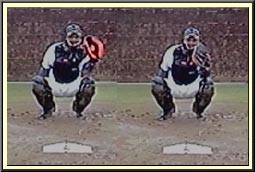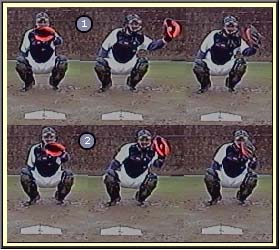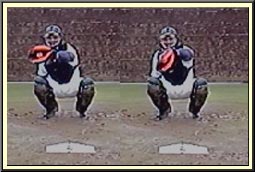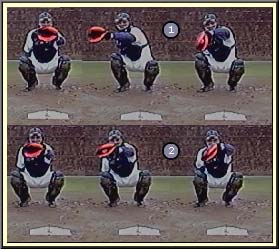Catching - Framing
What Is Framing?
The art of framing the baseball gives the illusion to the umpire that a ball just off the plate actually crossed the plate. It also gives the impression that the ball 5 or 6 inches off the plate just missed. The umpire may get the impression that the pitcher has very good control which can influence his calling of balls and strikes.
How Do You Frame A Pitch?
When you frame the pitch, try to give the umpire a clear view of where you caught the ball. To do this, catch the ball out in front of your body with a slightly bent elbow. If you catch the ball close to your body, it doesn't matter what you do with your glove, the umpire will not see it. Once you have caught the ball, you move your arm and/or glove a couple of inches towards the center of the plate.
Setup And Target
If you call for a pitch on the outside part of the plate, make sure you setup behind the plate a few inches in that direction. This will allow you to give a target on the outer half of the plate without having to reach. This puts you in a good position to frame a pitch.
Sway
When receiving the ball and framing it's important to move your body along with your glove. By swaying slightly with your body, you reduce the amount of arm movement required to catch the ball. If you setup on the outer half of the plate and can sway a couple of more inches, you can give the impression that the pitch just off the plate was thrown right on target.
Just Inside

This is a pitch that you want to convince the umpire is a strike. If you have your glove in a vertical position, reach slightly to your left and as you catch the ball, turn your wrist toward the center of the plate. If you catch the ball on the outside portion of your glove, this turn of the wrist can give the umpire the impression that the pitch caught the corner. Hold the glove there for a second to give him a good look. A common mistake of young catchers is to move your entire arm towards the center of the plate. Remember you're trying to create an illusion, not trying to trick the umpire. I trick may work once or twice, but creating a good illusion, may give you an inch or two extra for the entire game.
Inside - Sway And Frame

On a pitch more than a couple inches inside, frame the pitch with your arm and your body. As the pitch comes in, sway your upper body towards the pitch. This makes the pitch appear to be closer to the plate than if you simply stick your arm out to catch it. This technique can save a strike from being called a ball if you happen to be set up outside and the pitch comes across the inside corner.
The picture above shows 2 examples to demonstrate the visual difference that can be made by setup and swaying.
In example 1, the catcher is setup in the center of the plate and doesn't sway to the pitch but reaches only with his arm. Once the ball is caught, the attempt to frame still leaves the glove off the plate, with a lot of arm movement.
In example 2, the catcher has setup a couple of inches to the inside. As the pitch comes in he has swayed his upper body toward the pitch. Even though he still has to reach for the pitch, the movement is not as drastic as in the first example. After catching the pitch the catcher has started to sway his body back. This and a turn of the wrist allows him to frame a pitch that is a few inches of the plate over the inside corner of the plate. The movement is smooth and not drastic. Even if he doesn't get that call, he has given the impression that a pitch 4 or 5 inches off the plate, just missed. This will increase the chance of getting the call on the ball that is an inch or 2 off the plate.
Player Tip
Don't save your sway technique for pitches that are well of the plate. Remember you are trying to give the impression that the pitcher has good control. The less you have to move your glove, the better the impression. With that said, don't go overboard. Staying balanced and comfortable behind the plate is essential.
Just Outside

Unless you setup outside, you will need to catch the ball backhanded. As you reach across and backhand the ball, catch it and again turn your wrist in toward the center of the plate. Catch the ball and give back towards yourself framing the pitch as you do. Keep the motion smooth. If you setup outside and sway, you may be able to catch this pitch without having to reach much across your body. This will give the impression that the ball is closer to the plate than if you have to reach a long way. Of course, the first priority is to catch it cleanly, so don't try to be too fine, especially with runners on base.
The image above is an example of setting up on the outer half of the plate and using a slight sway. Here a pitch that is just off the outside corner has been framed over the plate without much arm movement.
Outside

On the pitch that is farther outside, use the same sway technique that you use on the inside pitch described on page 1.
The picture above shows another example of the difference that can be made by setup and swaying.
In example 1, the catcher is setup in the center of the plate and doesn't sway to the pitch but reaches only with his arm. Once the ball is caught, the attempt to frame still leaves the glove off the plate, with a lot of arm movement.
In example 2, the catcher has setup a couple of inches to the outside. As the pitch comes in he has swayed his upper body toward the pitch. Even though he still has to reach for the pitch, the movement is not as drastic as in the first example. After catching the pitch the catcher has started to sway his body back. This and a turn of the wrist allows him to frame a pitch that is a few inches off the plate over the outside corner of the plate. Again, the movement is smooth. By effectively swaying and framing the pitch, you can often stretch the strike zone. Something your pitcher will appreciate.
Player Tip
As has been mentioned several times in this section, framing should be a smooth motion that gives an illusion. I often see young catchers that jerk their glove to the center of the plate after each pitch. All this does is teach the umpire to disregard the position of the glove after the ball is caught. Instead of creating an illusion and allowing the umpire to double check by looking at your glove, he will have to make the call based on his first impression. This type of "framing" can be a detriment to the pitcher rather than a benefit.
High
The high pitch can be difficult to frame since the umpire has a good view as it comes in. I instruct my catchers to minimize the movement to the wrist when framing this pitch. The reason is that I don't want the umpire to clearly see my catcher drop his arm 2 or 3 inches after catching the ball. We may not get this pitch to be called a strike, but I want the umpire to get the impression that the catcher is keeping the glove where he has caught the ball. This will hopefully help us out on other borderline pitches.
To frame this pitch, move your wrist forward to drop the top of your glove down as you catch the ball.
Low
This pitch is difficult to frame because even if you frame the pitch the umpire may not be able to see your glove. On this pitch, how you catch the ball is more important than how you frame it afterward. Anytime you catch the ball with your glove pointing straight down, you are giving the impression that the ball is low. Obviously this can't be avoided on some pitches, but on that borderline pitch just below the knee, try to catch the ball with your arm horizontal to the ground.
It's Already A Strike
When catching a ball that is already a strike, simply turn your glove slightly in toward the middle of the plate as you catch it. Don't move your arm and your movement shouldn't be extreme. The reason you frame the pitch is so you don't train the umpire that the only time you turn your glove is on a ball. Another reason to frame a strike is to increase the chance of a ball on the corner being called a strike rather than a ball.
Most Recent Blog Posts
Working With Players on Focusing on the Correct Part of the Baseball when Hitting (October 15 2016)
Getting More Accurate Throws From Your Team (April 5 2016)
Thank you for providing all the instruction on your site. I've played a lot of positions but I've never been a catcher, so the catching section has been great to help me feel confident in my ability to coach that position.
- Phil G.







